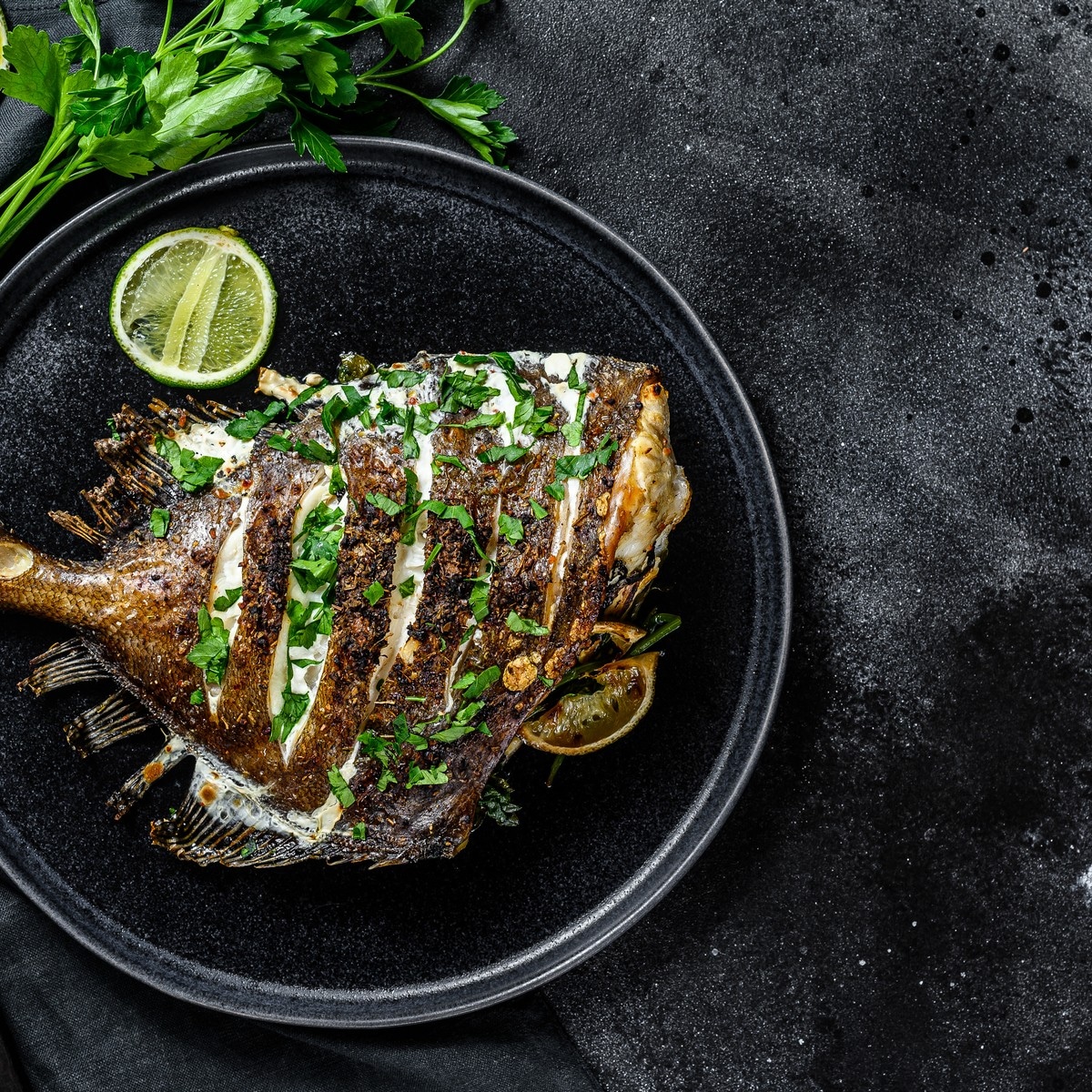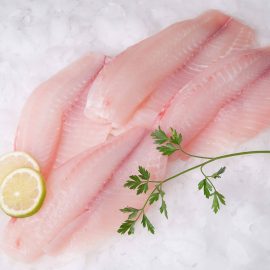
Introduction
The John Dory is a unique marine fish species highly regarded due to its unique flavour and texture. While primarily valued as a food and ornamental fish, its popularity remains strong, with it being a highly sought-after species for commercial, sport and subsistence fishing.
Its mild flavour, contrasted with a firm texture, makes it a favourite among chefs and diners. At the same time, its unique qualities and supposedly aphrodisiac properties have made it highly desirable in fish markets worldwide.
Description
The John Dory, also known as St. Pierre or Peters Fish, is a ray-finned fish belonging to the Zeidae and the genus Zeus. It is closely related to the Atlantic dory, the Pacific dory, and the spotted John Dory and has a yellow tint.
It is a species of marine fish found in abundance along the East Coast of North America and native to the Mediterranean Sea, West Africa, and the eastern Atlantic Ocean.
With a mild, sweet flavour, firm texture, and outstanding recipe versatility, John Dory has been an essential fishing species since at least the 16th century, becoming increasingly popular since the 1950s and 1980s, respectively.
John Dory is critical to the functioning of marine ecosystems, as its presence strengthens the food web in many habitats. This species provides insight into the interconnectedness of global economies, indicating the importance of marine life conservation.
Physical Characteristics
The John Dory is a bottom-dwelling ray-finned fish with a long and slender compressed body, growing up to 20 inches in length.
Generally, it has a broad, flat, slightly rounded head with small eyes that are usually covered in slime. Its scales are large and rough, providing protection and aiding in the quick healing of any injury.
A distinctive dark spot near its left pectoral fin distinguishes its colouring from white to yellowish-green mottled with reddish browns, stripes, and wavy edges.
Near its tail, it has two small dorsal fins and an anal fin, along with a long and sharp snout or beak. Its laterally compressed body allows it to swim forward and backwards efficiently.
Habitat and Feeding
The John Dory is a solitary creature typically found inhabiting the Atlantic Ocean’s deep waters, the coasts of the Mediterranean Sea, and parts of the Indian Ocean. Groups of up to 100 can, however, occasionally be seen.
They are found in sandy and muddy bottom areas in the open ocean and shallow coastal waters near rocky structures, coral reefs, and wrecks. It is reported to stay in depth range between 30 and 600 meters in waters with temperatures ranging from 8-26 C.
It is found in tropical and warm temperate zones, making it a major commercial species in some European countries.
Distribution of Stocks
The distribution of John Dory ranges from North Africa to the Red Sea and Cape Verde Islands, across the Atlantic, from Europe to the Caribbean, and along the South American coast. It is found near South Korea, New Zealand, Australia, and Hawaii in the Pacific. This species is also common from Newfoundland to Scandinavia in the Atlantic and from South Africa to the Mediterranean Sea.
It primarily feeds on small bony sea fishes and molluscs as predatory fish. It is also occasionally found in saltwater aquariums, as it is a highly prized ornamental fish.
Commercial Fishing
John Dory is highly sought after by commercial fisheries due to their size and flavorful flesh. In Japan, they are often consumed raw and are a popular dish.
Literature suggests they may be threatened due to their low reproductive rate, with each female only releasing between 0.1 and 1 million eggs per spawn. Various management and conservation measures have been implemented to ensure John Dory populations are managed sustainably.
Population and Conservation
Unfortunately, John Dory has become increasingly vulnerable due to overfishing and the subsequent need to regulate this species’ population better. To this end, considerable efforts have been made to conserve this species, such as implementing stock assessments and establishing aquaculture operations and aquaponic systems. These initiatives aim to re-establish critical habitats disturbed by environmental factors such as global warming and pollution resulting from unsustainable aquaculture practices.
Sustainability
The global fishing industry is becoming increasingly aware of concerns regarding the sustainability of particular species in marine habitats. The Marine biological association in each country has taken necessary steps to practice stock assessments to more sustainably fish and reduce or eliminate the risk of overfishing certain species.
Furthermore, the industry encourages the responsible and considered consumption of species such as John Dory and publicises the health benefits of eating fish, as it is an essential part of our diets.
John Dory’s Diet
As an active predator, John Dory typically feeds on its prey, such as the crustaceans, molluscs, and smaller fish.
Life Cycle of John Dory
Spawning usually occurs between November-February, with John Dories typically laying their eggs in shallow waters of the coastal regions. Females will lay their eggs on the ocean floor, which acts as an adhesive, with each spawning usually giving off an average of 1 million eggs.
John Dory engages in a peculiar courtship behaviour to reproduce. Males will create a circular pattern with their bodies, whirling around the female, and the female will fertilise her eggs within the ring. This motion helps to keep the eggs safe from predators and allows the male to guard them until they hatch.
The eggs usually take 24-48 hours to hatch, and the larvae will reach their juvenile stage after 6-8 weeks.
Juveniles will begin to feed voraciously, primarily on tiny organisms and plankton, and adults will forage for food along the sea floor, preying on small invertebrates, crustaceans, and sometimes other fish. At the end of its life cycle, John Dory will again gather in schools and spawn in the same areas where they were bred.
The life cycle of a John Dory typically lasts between 5-9 years, with its maturity roughly occurring at 3-4 years old.
Classification
John Dory is classified as an Actinopterygii. The classification of John Dory is Kingdom: Animalia; Phylum: Chordata; Class: Actinopterygii; Order: Zeiformes; Family: Zeidae; Genus: Zeus; Species: Z. faber.
Etymology
The John Dory’s distinct black spot near its side is thought to be related to the origin of its name. In France, the fish is known as St Pierre, meaning ‘stone Peter’, referencing the mark. Some believe the English name John Dory was derived from St Peter because of his miraculous fish catch.
Additionally, the Latin word dorsum, which translates to ‘back’, maybe a reference to the fish’s pale dorsal fin. Although there is no definitive proof, John Dory is still known as a much-valued fish that has been used for consumption and sport fishing for over 400 years.
Culinary Preparation
The John Dory has a slightly oily texture and delicate, mild, and sweet flesh. It can be cooked in several ways, including grilling, baking, frying, and sautéing. Its flaky flesh pairs nicely with light sauces, herbs, and spices, enabling chefs to bring out its subtle flavour. It is often paired with fresh vegetables and a white wine sauce.
Significance
The John Dory is incredibly resilient and able to survive in various environmental conditions due to its thick scales. Over the centuries, people have recognised its importance for human consumption, and it is popular in many commercial fisheries, providing a sustainable source of protein.
Its agile swimming abilities, combined with its natural camouflage, give it an advantage over most of its predators in the wild. Its versatility, adaptability, and resilience make it easily one of the most prominent fish in our oceans. It is sure to remain a staple in the fishing industry for many years to come.

Popularity and Availability
The John Dory is a popular fish in many seafood restaurants and is often served whole. It is also sold as fillets and is a popular choice for special meals and holidays such as birthdays and family dinners. Fish is generally considered a healthy food choice, given its lean and nutrient-packed profile.
Nutritional Values
John Dory is an excellent source of lean protein and is low in saturated fat and cholesterol. It also contains high omega-3 polyunsaturated fatty acids, potassium, and magnesium, which can help support the body’s cardiovascular system.
Furthermore, this fish species is a good source of Vitamin A, C, D, Vitamin E, Vitamin K, Calcium, Magnesium, Potassium, Selenium, Phosphorus, and Zinc. Finally, John Dory contains a high level of dietary sodium.
As a result, it is considered a healthy food choice and is regularly served in restaurants and households.
Health Benefits
John Dory is low in fat yet high in proteins and vitamins, with a lean flesh that is ideal for absorbing the flavours of the cooked ingredients. It has a mild, easily overwhelmed flavour, making it a healthy yet flavorful choice when appropriately cooked. It provides a restaurant-quality option that is both sustainable and healthful.
The array of nutrients in John Dory makes it an excellent choice for improving overall health and well-being. The omega-3 polyunsaturated fatty acids can help reduce the risk of heart disease and stroke, while the high levels of vitamins and minerals help support a range of bodily functions.
Furthermore, the potassium and magnesium found in John Dory can help keep blood pressure levels stable and protect against stroke. Finally, the calcium content can help strengthen bones and joints.
Versatility
John Dory is a versatile white fish that can be enjoyed in various ways. Fish is the star of any meal with the right accompaniments and cooking methods. When cooking, a medium-high heat should be used and ensure not to overcook the fish as this will cause it to dry out and negatively affect its flavour.
Finally, John Dory must be enjoyed when freshly cooked for the best taste.
Cooking and Serving Options
John Dory is a versatile ingredient that can be cooked in various ways, such as pan-frying, baking, grilling, and poaching. It is often served with a range of sauces, such as citrus-based sauces, beurre blanc, or white wine sauces, and is popular in French cuisine.
When baking, poaching, or steaming, use a low heat in order to keep the flesh as moist and tender as possible for the best taste. Increasing heat should ensure the fish does not stick to the pan when grillied or pan-fried.
In Provencal cuisine, oven-baked John Dory is a typical dish, while grilled John Dory is a popular alternative, sometimes served with a citrus sauce or Creole-Style spice rub.
John Dory is also frequently served alongside spinach, potatoes, tomatoes, olives, capers, mushrooms, and artichokes. It is often paired with white wines such as Sauvignon Blanc and Chardonnay.
Preparation
Before cooking John Dory, clean and scale the fish and cut it open along the backbone and remove its guts. When preparing to pan-fry, it is vital to fillet the fish and salt it beforehand to ensure the best flavour and texture.
John Dory should be cooked as soon as possible after it is caught, as its delicate flesh can quickly become overcooked or dry. However, when cooked properly, it makes an excellent meal that is both easy to prepare and full of flavour.
Flavorful Pairings
When it comes to creating a dish with John Dory, the possibilities are endless. Various fresh vegetables pair exceptionally well with delicate fish, such as asparagus, bell peppers, Brussels sprouts, carrots, cauliflower, and fennel. These vegetables can be roasted or sautéed, creating a light yet utterly delicious accompaniments.
For an added burst of flavour, adding a light squeeze of lemon juice or splash of white wine is a traditional way of bringing out the sweet, mild taste of John Dory. For a more flavorful dish, consider topping the fish with a creamy dill sauce, rich pesto-like dressings, tomatoes, capers, olives, and various herbs and spices.
John Dory can also be served with various starches and grains, such as potatoes, couscous, quinoa, and farro, as well as a light, crispy polenta. For the fish’s flavour to be preserved, it is crucial to be aware of the delicate flavour profile and create accompaniments which do not dominate the fish but enhance it instead.
Flavor Enhancements
John Dory can be served with various accompaniments and sauces to bring out its delicate flavours, such as lemon or garlic butter, citrus fruits, olives, and capers.
When broiling, brush the fish with butter and herbs, then top with a crust of breadcrumbs, garlic, and more spices. Marinating in an egg and flour batter is recommended, and then frying in oil.
If using the roasting method, score the flesh of the fish first before adding olive oil, herbs, and citrus wedges to the baking dish.
Popular Recipes
Many popular recipes use John Dory, such as rose water and lemon John Dory, John Dory with tomato sauce, and John Dory with almonds.
It can also be poached in white wine. Other popular sides to serve alongside it include mashed potatoes, roasted potatoes, risotto, green beans, and various herbs like parsley or dill, capers, and olives.
In some regions, it is also served with French fries, risotto, or a salad.
Conclusion
The John Dory is a highly appreciated species, in demand across the globe. Several studies have been conducted to build upon the understanding of the species’ ecology, its nutritional value, and its role in fisheries.
The species is popular among recreational and commercial fishermen, and extensively documented books, titles, and articles offer guidance on encountering and cooking the species.
It is increasingly being chosen by people worldwide for its unique flavour, delicate texture and nutritional value—an excellent choice for those looking for an exciting and healthy fish to add to their diet.

